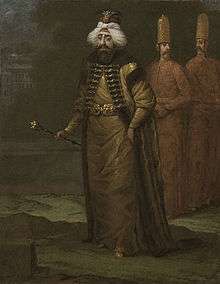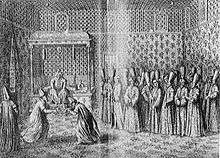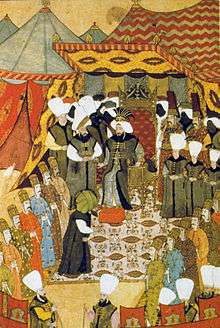Ahmed III
| Ahmed III حمد ثالث | |||||
|---|---|---|---|---|---|
|
Caliph of Islam Amir al-Mu'minin Sultan of the Ottoman Empire Custodian of the Two Holy Mosques | |||||
 | |||||
| 23rd Ottoman Sultan (Emperor) | |||||
| Reign | August 22, 1703 – October 1, 1730 | ||||
| Predecessor | Mustafa II | ||||
| Successor | Mahmud I | ||||
| Born | December 1673 | ||||
| Died |
1 July 1736 (aged 62) Constantinople | ||||
| Consorts |
Mihrişah Sultan Şermi Sultan | ||||
| |||||
| Dynasty | House of Osman | ||||
| Father | Mehmed IV | ||||
| Mother | Emetullah Rabia Gülnûş Sultan | ||||
| Religion | Sunni Islam | ||||
| Tughra |
| ||||
Ahmed III (Ottoman Turkish: احمد ثالث, Aḥmed-i sālis) (30/31 December 1673 – 1 July 1736) was Sultan of the Ottoman Empire and a son of Sultan Mehmed IV (r. 1648–87). His mother was Emetullah Rabia Gülnûş Sultan, originally named Evmania Voria, who was an ethnic Greek.[1][2][3][4][5] He was born at Hajioglupazari, in Dobruja. He succeeded to the throne in 1703 on the abdication of his brother Mustafa II (1695–1703).[6] Nevşehirli Damat İbrahim Pasha and the Sultan's daughter, Hatice Sultan (wife of the former) directed the government from 1718 to 1730, a period referred to as the Tulip Era.
Biography
Ahmed III cultivated good relations with France, doubtless in view of Russia's menacing attitude. He afforded refuge in Ottoman territory to Charles XII of Sweden (1682–1718) after the Swedish defeat at the hands of Peter I of Russia (1672–1725) in the Battle of Poltava of 1709.[7] In 1710 Charles XII convinced Sultan Ahmed III to declare war against Russia, and the Ottoman forces under Baltacı Mehmet Pasha won a major victory at the Battle of Prut. In the aftermath, Russia returned Azov back to the Ottomans, agreed to demolish the fortress of Taganrog and others in the area, and to stop interfering in the affairs of the Polish–Lithuanian Commonwealth.
Forced against his will into war with Russia, Ahmed III came nearer than any Ottoman sovereign before or since to breaking the power of his northern rival, whose armies his grand vizier Nevşehirli Damat İbrahim Pasha succeeded in completely surrounding at the Pruth River Campaign in 1711.[6] The subsequent Ottoman victories against Russia enabled the Ottoman Empire to advance to Moscow, had the Sultan wished. However, this was halted as a report reached Constantinople that the Safavids were invading the Ottoman Empire, causing a period of panic, turning the Sultan's attention away from Russia.
Sultan Ahmed III had become unpopular by reason of the excessive pomp and costly luxury in which he and his principal officers indulged; on September 20, 1730, a mutinous riot of seventeen Janissaries, led by the Albanian Patrona Halil, was aided by the citizens as well as the military until it swelled into an insurrection in front of which the Sultan was forced to give up the throne.
Ahmed voluntarily led his nephew Mahmud I (1730–54) to the seat of sovereignty and paid allegiance to him as Sultan of the Empire. He then retired to the Kafes previously occupied by Mahmud and died at Topkapı Palace after six years of confinement.
Character of Ahmed III's rule



The reign of Ahmed III lasted for twenty-seven years and was not unsuccessful. The recovery of Azov and the Morea, and the conquest of part of Persia, managed to counterbalance the Balkan territory ceded to the Habsburg Monarchy through the Treaty of Passarowitz, after the Ottoman Empire was defeated in Austro-Turkish War of 1716–18. In 1716, he sent an army of 33,000 men to capture Corfu from the Republic of Venice but that expedition eventually failed,
Ahmed III left the finances of the Ottoman Empire in a flourishing condition, which had remarkably been obtained without excessive taxation or extortion procedures. He was a cultivated patron of literature and art, and it was in his time that the first printing press authorized to use the Arabic or Turkish languages was set up in Constantinople, operated by Ibrahim Muteferrika (while the printing press had been introduced to Constantinople in 1480, all works published before 1729 were in Greek, Armenian, or Hebrew).
It was in this reign that an important change in the government of the Danubian Principalities was introduced: previously, the Porte had appointed Hospodars, usually native Moldavian and Wallachian boyars, to administer those provinces; after the Russian campaign of 1711, during which Peter the Great found an ally in Moldavia Prince Dimitrie Cantemir, the Porte began overtly deputizing Phanariote Greeks in that region, and extended the system to Wallachia after Prince Stefan Cantacuzino established links with Eugene of Savoy. The Phanariotes constituted a kind of Dhimmi nobility, which supplied the Porte with functionaries in many important departments of the state.
Relations with the Mughal Empire
Jahandar Shah
In the year 1712, the Mughal Emperor Jahandar Shah, a grandson of Aurangzeb sent gifts to the Ottoman Sultan Ahmad III and referred to himself as the Ottoman Sultan's devoted admirer.[8]
Farrukhsiyar
The Mughal Emperor Farrukhsiyar a grandson of Aurangzeb, is also known to have sent a letter to the Ottomans but this time it was received by the Grand Vizier Nevşehirli Damad Ibrahim Pasha providing a graphic description of the efforts of the Mughal commander Syed Hassan Ali Khan Barha against the Rajput and Maratha rebellion.[9]
Marriages and issue [10]
Consorts
- Emetullah Banu Bas Kadin Effendi (d. 1732), daughter of 'Abdu'l Minnan.
- Rukiya Kadin Effendi (d. 1738), styled 2nd Kadin Effendi.
- Aminā (Emine) Mihrişah Effendi, styled 2nd Kadin Effendi; mother of Mustafa III.
- Khadija Kadin Effendi (d. 1712), styled 2nd Kadin.
- Shahin Kadin Effendi (d. 1723), styled 3rd Kadin.
- Rabia Sharmi Effendi, mother of Abdul Hamid I.
- Amina Mushalli Kadin Effendi (d. 1750).
- Zainab Kadin Effendi (d. 1757).
- Gul-Shan Kadin Effendi (d. 1731).
- Fatima Kadin Effendi (d. 1732).
- Ummu Kulsum Kadin Effendi (d. 1768).
- Husn-i-Shah Kadin (d. 1733).
- Fatima Huma-Shah Kadin Effendi (d. 1742).
- Hurram Kadin Effendi (1692–1760).
- Mayli Kadin Effendi.
- Nazifa Kadin Effendi.
- Nijad Kadin Effendi.
- Hanifa Kadin Effendi.
- Aisha Buhari Khanum Effendi alias Mihri Haji Iqbal.
- Shayasta Khanum (d. 1722).
- Hatim Khanum Effendi (1695–1772).
Sons
- Şehzade Mehmed (1 March 1697 – June 1703).
- Şehzade Ibrahim (1704 – bef. 1720).
- Şehzade Mehmed (25 November 1705 – 20 June 1706).
- Şehzade Murad (January 1706 – 5 April 1708).
- Şehzade Isa (23 February 1706 – 25 May 1706), son of Hurram Kadin Effendi.
- Şehzade Ali (18 June 1706 – 12 September 1706).
- Şehzade Selim (6 September 1707 – 4 May 1708), son of Hurram Kadin Effendi.
- Şehzade Murad (17 November 1707 – died young).
- Şehzade Murad (4 February 1708 – 1 April 1708).
- Şehzade Abdul Majid (12 December 1709 – 8 March 1710), twin with Abdul Malik.
- Şehzade Abdul Malik (12 December 1709 – 7 March 1711), twin with Abdul Majid.
- Şehzade Mustafa (born 1710 – died young).
- Şehzade Sultan Sulaiman Khan (25 August 1710 – 11 December 1732), son of Aminā (Emine) Mihrişah Effendi.
- Şehzade Mehmed (17 October 1712 – 15 July 1713), son of Hurram Kadin Effendi.
- Şehzade Selim (1712 – 11 July 1715).
- Şehzade Mahmud (17 October 1713 – 22 December 1756).
- Şehzade Selim (20 April 1715 – February 1718), twin with Saliha Sultan; son of Hatim Khanum Effendi.
- Şehzade .... (1 December 1715 – died young).
- Şehzade Sultan Mehmed Khan (1 January 1717 – murdered 22 December 1756), Crown Prince since 13 December 1754.
- Mustafa III (28 January 1717 – 21 January 1774), son of Aminā (Emine) Mihrişah Effendi.
- Şehzade Sultan Bayazid Khan (4 October 1718 – 25 January 1771), Crown Prince since 30 January 1757; son of Aminā (Emine) Mihr-î-Mâh Effendi.
- Şehzade Hasan.
- Şehzade Selim (6 December 1718 – died young).
- Şehzade .... (September 1719 – 12 December 1719).
- Şehzade Abdullah (18 December 1719 – 19 December 1719), son of Hurram Kadin Effendi.
- Şehzade Ibrahim (9 January 1721 – 5 April 1721).
- Şehzade Murad (born and died 4 April 1721).
- Şehzade .... (born and died 20 August 1722).
- Şehzade Orkhan (born 1722 – died young), son of Hurram Kadin Effendi.
- Şehzade Sultan Numan Khan (22 February 1723 – 29 December 1764), Second Crown Prince since 30 January 1757.
- Şehzade Abdul Majid (1723 – aft. 1774).
- Abdul Hamid I (20 March 1725 – 7 April 1789), son of Rabia Sharmi Effendi.
- Şehzade Saifuddin (3 February 1728 – 1732).
- Şehzade Ahmed (8 March 1728 – 1728).
Daughters
- Fatma Sultan (22 October 1704 – 3 January 1733), daughter of Emetullah Banu Bas Kadin Effendi. Married:
- firstly 13 May 1709, H.H. Damad Fazil Ali Pasha, Grand Vizier 1713–1716.
- secondly 18 February 1717, H.H. Damad Ibrahim Pasha, Grand Vizier.
- Aisha Sultan (1705–1706).
- Khadija Sultan (22 December 1706 – 21 January 1708), daughter of Rukiya Kadin Effendi.
- Rukiya Sultan (2 May 1707 – 4 May 1708).
- Zainab Sultan (7 February 1708 – 14 November 1708), twin with Ümmügülsüm Sultan; daughter of Aminā (Emine) Mihrişah Effendi.
- Ümmügülsüm Sultan (7 February 1708 – November 1732), twin with Zainab Sultan; daughter of Aminā (Emine) Mihrişah Effendi. Married:
- firstly Damad Abdu-Rahman Pasha, 4th Vizier 1708.
- secondly 6 January 1724 Damad Genc Ali Pasha, Vizier 1724.
- Zainab Sultan (5 January 1710 – 1 August 1710).
- Khadija Sultan (8 February 1710 – died young).
- Khadija Sultan (28 September 1710 – 1738). Married:
- firstly 6 March 1724, Damad 'Ali Pasha.
- secondly Damad Halil Agha.
- Atika Sultan (28 February 1712 – 1737). Married 6t January 1724 Damad Muhammad Pasha.
- Rukiya Sultan (7 March 1712 – 1 October 1714).
- Zainab Sultan (8 April 1714 – 25 March 1774), daughter of Rabia Sharmi Effendi; the Zeynep Sultan Mosque was built by her order. Married:
- firstly 21 October 1727, Damad Mustafa Pasha.
- secondly February 1765, Damad Malik Muhammad Pasha, Vizier 1753.
- Saliha Sultana (20 April 1715 – 11 October 1778), twin with Şehzade Selim; daughter of Hatim Khanum Effendi. Married:
- firstly May 1728, Damad Sari Mustafa Pasha.
- secondly 30 April 1740, Damad 'Ali Pasha, Vizier 1762.
- thirdly December 1744, Damad Yahya Pasha, Vizier 1734.
- fourthly 28 February 1757, Damad Khoja Muhammad Ragib Pasha, Vizier 1744.
- fifthly May 1764, Admiral H.E. Damad Agha Muhammad Pasha, Vizier 1759.
- Aisha Sultana (11 October 1715 – 9 July 1775), daughter of Amina Mushalli Kadin Effendi. Married:
- firstly 1733, H.H. Damad Muhammad Pasha, Grand Vizier.
- secondly January 1744, Damad Ahmed Ratib Pasha, Vizier 1740.
- thirdly 16 January 1759, Field Marshal H.H. Damad Muhammad Pasha Jahangiri, Master-General of the Ordnance, Governor of Bosnia 1767-1770; 1775-1776 and Egypt 1783-1785, Grand Vizier 1770-1771.
- Ferdana Sultan (1718 – died young).
- Umm us-Salima Sultan (born and died 26 December 1718).
- Umm us-Salima Sultan (born and died 1719).
- Nazifa Sultan (1719–1721).
- Rabia Sultan (19 November 1719 – 1721).
- Khadija Sultan (20 November 1719 – 1738). Married 1734, H.H. Damad Hafiz Ahmed Pasha.
- Raihana Sultan (born and died 12 December 1719).
- Baikhan Sultan (born and died 1720).
- Amina Sultan (1720–1723).
- Rukiya Sultan (born and died 30 January 1720).
- Ummatullah Sultan (23 December 1719 – 5 February 1720).
- Naila Sultan (1722 – 10 December 1726).
- Rabia Sultan (1722–1729).
- Ummatullah Sultan (17 September 1723 – 28 January 1724).
- Umm us-Salima Sultan (1725–1732).
- Musta Sultan (May 1725 – 29 December 1764).
- Esma Sultan (14 March 1726 – 13 August 1788), daughter of Zainab Kadin Effendi. Married:
- firstly 19 February 1743, Damad Yakub Pasha, Master-General of the Ordnance 1731-1733, Vizier 1733.
- secondly 1744, Damad Pir Mustafa Pasha.
- thirdly 24 June 1758, Damad Muhammad Pasha.
- Sabiha Sultan (26 November 1726 – 3 December 1726).
- Rabia Sultan (4 August 1727 – 4 April 1728).
- Zubaida Sultana (29 March 1728 – 4 June 1756), daughter of Hatim Khanum Effendi. Married:
- firstly 6 January 1748, Damad Sulaiman Pasha, Cdr. of the Adrianople Imperial Bodyguard.
- secondly 16 December 1749, Damad Numan Pasha.
- Umm ul-Habiba Sultana (1729–1730).
- Akila Sultana (1730–1737).
In fiction
In Voltaire's Candide, the eponymous main character meets the deposed Ahmed III on a ship from Venice to Constantinople. The Sultan is in the company of five other deposed European monarchs, and he tells Candide, who initially doubts his credentials:
I am not jesting, my name is Achmet III. For several years I was Sultan; I dethroned my brother; my nephew dethroned me; they cut off the heads of my viziers; I am ending my days in the old seraglio; my nephew, Sultan Mahmoud, sometimes allows me to travel for my health, and I have come to spend the Carnival at Venice."
This episode was taken up by the modern Turkish writer Nedim Gürsel as the setting of his 2001 novel Le voyage de Candide à Istanbul.
In fact, there is no evidence of the deposed Sultan being allowed to make such foreign travels, nor did Voltaire (or Gürsel) assert that it had any actual historical foundation.
See also
- Fountain of Ahmed III
- Fountain of Ahmed III (Üsküdar)
- Ibrahim Muteferrika
- Esma Sultan, daughter of Ahmed III
References
- ↑ Freely, John (2001). The lost Messiah. Viking. p. 132. ISBN 0-670-88675-0.
He set up his harem there, his favourite being Rabia Giilniis Ummetiillah, a Greek girl from Rethymnon on Crete
- ↑ Bromley, J. S. (1957). The New Cambridge Modern History. University of California: University Press. p. 554. ISBN 0-521-22128-5.
the mother of Mustafa II and Ahmed III was a Greek
- ↑ Sardo, Eugenio Lo (1999). Tra greci e turchi: fonti diplomatiche italiane sul Settecento ottomano. Consiglio nazionale delle ricerche. p. 82. ISBN 88-8080-014-0.
Their mother, a Greek, lady named Rabia Gülnûş, continued to wield influence as the Valide Sultan - mother of the reigning sultan
- ↑ Library Information and Research Service (2005). The Middle East. Library Information and Research Service. p. 91.
She was the daughter of a Greek family and she was the mother of Mustafa II (1664–1703), and Ahmed III (1673–1736).
- ↑ Baker, Anthony E - Freely, John (1993). The Bosphorus. Redhouse Press. p. 146. ISBN 975-413-062-0.
The Valide Sultan was born Evmania Voria, daughter of a Greek priest in a village near Rethymnon on Crete. She was captured by the Turks when they took Rethymnon in 1645.
- 1 2
 One or more of the preceding sentences incorporates text from a publication now in the public domain: Chisholm, Hugh, ed. (1911). "Ahmed III.". Encyclopædia Britannica. 1 (11th ed.). Cambridge University Press. p. 431.
One or more of the preceding sentences incorporates text from a publication now in the public domain: Chisholm, Hugh, ed. (1911). "Ahmed III.". Encyclopædia Britannica. 1 (11th ed.). Cambridge University Press. p. 431. - ↑ Chisholm 1911.
- ↑ Farooqi, N.R. (1989). Mughal-Ottoman relations: a study of political & diplomatic relations between Mughal India and the Ottoman Empire, 1556-1748. Idarah-i Adabiyat-i Delli.
- ↑ Mughal-Ottoman relations: a study of political & diplomatic relations ... - Naimur Rahman Farooqi. Books.google.com. 1989. Retrieved 2012-04-29.
- ↑ "The Imperial House of Osman: Genealogy". Archived from the original on 2006-05-02. Retrieved 2006-05-02. [retrieved 4 March 2016].
Sources
- This article incorporates text from the History of Ottoman Turks (1878)
-
 This article incorporates text from a publication now in the public domain: Chisholm, Hugh, ed. (1911). "Ahmed III.". Encyclopædia Britannica (11th ed.). Cambridge University Press.
This article incorporates text from a publication now in the public domain: Chisholm, Hugh, ed. (1911). "Ahmed III.". Encyclopædia Britannica (11th ed.). Cambridge University Press.
External links
![]() Media related to Ahmed III at Wikimedia Commons+
Media related to Ahmed III at Wikimedia Commons+
![]() Works written by or about Ahmed III at Wikisource
Works written by or about Ahmed III at Wikisource
| Ahmed III Born: December 30, 1673 Died: July 1, 1736[aged 62] | ||
| Regnal titles | ||
|---|---|---|
| Preceded by Mustafa II |
Sultan of the Ottoman Empire August 22, 1703 – October 1 / 2, 1730 |
Succeeded by Mahmud I |
| Sunni Islam titles | ||
| Preceded by Mustafa II |
Caliph of Islam August 22, 1703 – October 1 / 2, 1730 |
Succeeded by Mahmud I |
